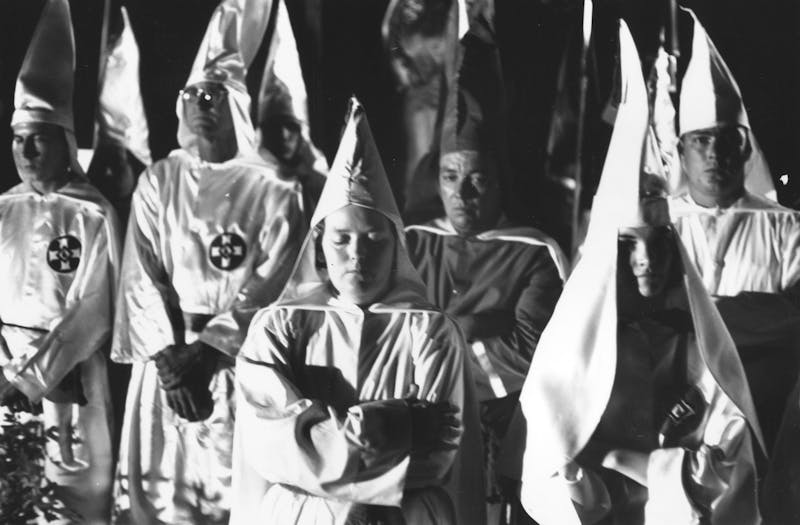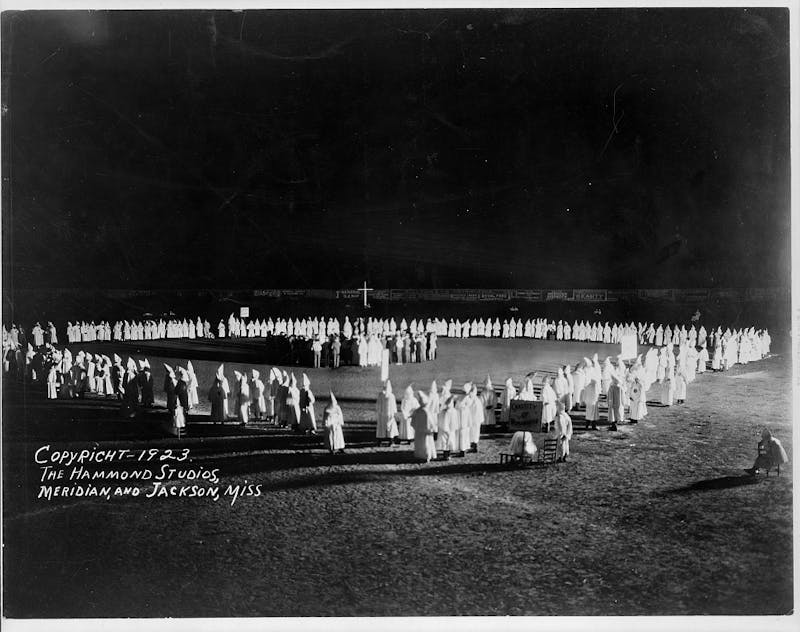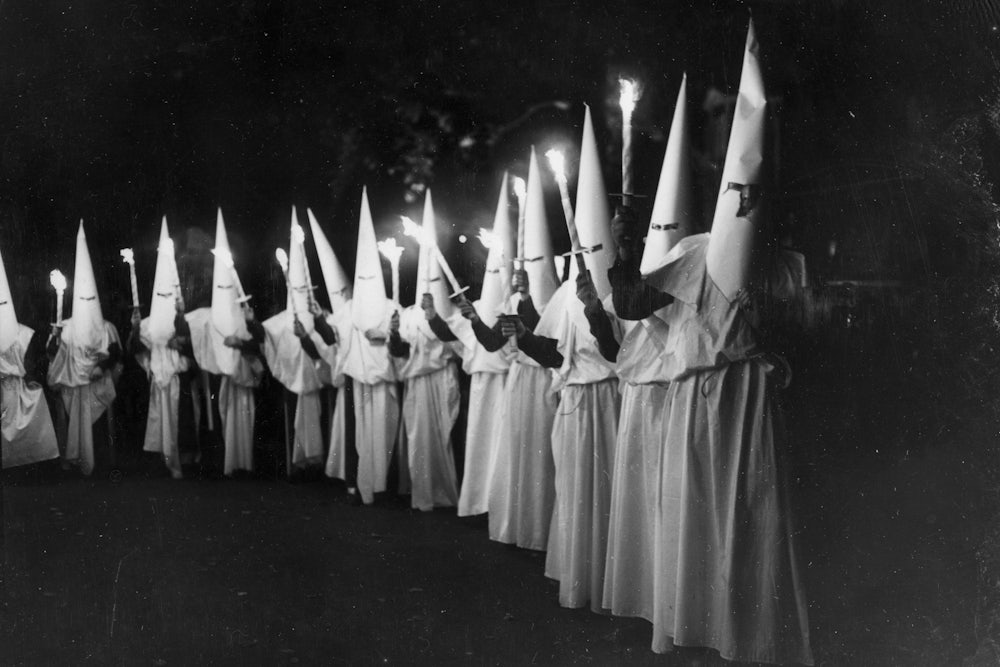Long before the artist Philip Guston was celebrated for his cartoonish paintings of pink flesh, cigarettes, and Klansmen, he was Phillip Goldstein, a member of the Los Angeles socialist Bloc of Mural Painters, and a kid on a road trip. In 1934, he and fellow painter Reuben Kadish bought a Ford coupe for $23 and drove to the city of Morelia, Mexico, where the university there had offered the artists a wall to embellish. Guston and Kadish’s fresco, depicting a swastika, hammer and sickle, cross, whips, nails, and electric chair cap, would go by many titles: The Struggle against War and Fascism; The Workers’ Struggle for Liberty, as Time magazine dubbed it; and The Struggle against Terrorism.
The Morelia mural swarms with robed men in peaked white hoods, suggesting one particular kind of terrorism for viewers then and now. But in 1934, when the mural was painted, the Ku Klux Klan’s white hood had been standardized for only two decades. How the Ku Klux Klan’s white hood came to be an icon of hatred is the story of image-makers: parade planners and playwrights, Hollywood and the mail-order catalog. Before they came along, though, the early Klan of the postwar South really was an “Invisible Empire,” emphasis on the invisibility: covert, decentralized, lacking hierarchy or uniforms, including the now-standard white, conical hood.
As historian Elaine Frantz Parsons has written in Midnight Rangers: Costume and Performance in the Reconstruction-Era Ku Klux Klan, while some early Klansmen did wear white, and later Klan mythology would claim they’d dressed up as Confederate ghosts, they usually drew on folk traditions of carnival, circus, minstrelsy, Mardi Gras—or the mid-century “Calico Indians,” hooded and masked farmers rebelling against upstate New York land laws. Klansmen wore gigantic animal horns, fake beards, coon-skin caps, or polka-dotted paper hats; they imitated French accents or barnyard animals; they played guitars to serenade victims. Some Klansmen wore pointed hats suggestive of wizards, dunces, or Pierrots; some wore everyday winter hoods, pillowcases, or flour sacks on their heads. Many early Klansman also wore blackface, simultaneously scapegoating and mocking their victims.

The lack of a formal uniform helped apologists like John H. Christy, a former Georgia Representative, testify to Congress in 1871: “Sometimes mischievous boys who want to have some fun go on a masquerading frolic to scare the negroes, but they do not interrupt them, do not hurt them in any way…stories are exaggerated, and it keeps up the impression among the negroes that there is really a Ku-Klux organization.” But pantomime costumes didn’t make the early Klan any less real, or brutal: one “colored” witness, Jacob Montgomery of Spartanburg, South Carolina, testified that the Klansmen who pistol-whipped, beat, and kicked him wore “white gowns, and some had flax linen, and some had red calico, and some red caps, and white horns stuffed with cotton. And some had flannel around coon-skin caps.” Another witness, Henry Lipscomb, testified that the Klan had killed two of his black neighbors and one white; they’d stripped, choked, and beaten him, and thrown a fireball into his house. The original Klan, anonymous, unaccountable, and hybrid, springing up in a woman’s gown, squirrel skin, or Venetian domino mask, violated its victims, then vanished, denying that any terrorism had occurred.
As Reconstruction ended and Southern white men reclaimed political power, they dropped out of the Klan, no longer limited to secret outlets for their violence. In 1872, the old Klan made a valedictory appearance: in public, in the Memphis Mardi Gras parade, revealing a new kind of pageantry that was no less ceremonial than chilling. Local Klan leaders and representatives from all the Southern states rode their own float, wearing black, conical hats with the skull and crossbones and “K.K.K.” in white. They staged the mock lynching of a man in blackface; they lassoed black spectators. The Klan itself was dying, but only because white supremacy was resurging right out in the open, with the sanction and participation of law enforcement and white society at large. Now they had Jim Crow laws. They had a criminal justice system that disproportionately punished Black people and imprisoned them in prison farms, on former plantations. They had lynch mobs, who no longer concealed their identities.
As Gwendolyn Chisholm would comment over a century
later, about the white supremacists who tortured and murdered James Byrd Jr. in
1998, “They look like normal people, don’t they? That’s the way they are nowadays—they don’t
wear hoods anymore.” Late nineteenth- and early twentieth-century lynchers also
looked like “normal people.” The complete absence of any hood, costume, or
concealment presented, literally, a new face of white supremacy. Journalist Ida
B. Wells-Barnett estimated that in the twenty-five years after the Civil War,
lynchers murdered 10,000 black Americans. Starting in the 1880s,
spectacle lynchings attracted crowds of up to 15,000 white
participant-witnesses, who booked special excursion trains to reach lynching
sites. They
snatched victims’ clothing, bone fragments, and organs as souvenirs; they photographed
themselves, smiling, posing with their kids beside the broken, burned
bodies of their victims; they scrapbooked the photos and mailed them as
postcards, confident that they’d never be held accountable for their terrorism. They didn’t wear hoods, because
they didn’t need to.

Lynchings were not spontaneous outbursts of “mob”
violence, but the predictable result of institutional support and the outright
participation of political elites. The lynchers of Leo Frank, in Marietta,
Georgia in 1915, included a former governor, judge, mayor and state legislator,
sheriff, county prosecutor, lawyer and banker, business owner, U.S. senator’s
son, and the founders of the Marietta Country Club. Frank’s atypical case—he was
white and Jewish—attracted media attention that thousands of black victims
never received, yet it exposed the ways that elites and authorities exonerated
themselves by blaming mob violence on so-called “crackers.” Meanwhile,
Mississippi governor, later U.S. senator James K. Vardaman said in 1907, “If it
is necessary every Negro in the state will be lynched; it will be done to
maintain white supremacy.”
Vardaman didn’t wear a white hood. Neither did the first woman U.S. senator, Rebecca Latimer Felton, who said in 1897, “If it takes lynching to protect woman’s dearest possession from drunken, ravening human beasts, then I say lynch a thousand a week if it becomes necessary.” They were cloaked, instead, in state power and popular support, and what their platforms concealed was the truth: Wells-Barnett’s reporting and the National Association for the Advancement of Colored People’s (NAACP) research had disproved the “thread bare lie” of the lynch mob as honorable defenders of white women. Besides the fact that the myth of the black rapist was a white supremacist fantasy, 70 percent of lynchers didn’t even bother to invoke it to justify their violence. Lynchers killed for such alleged offenses as “sassing,” wanting a drink of water, being “troublesome,” “conjuring,” and often, as in the murders of Mrs. Jake Cebrose and an eight-year-old child named Parks, no excuse at all.
Yet politicians still defended and abetted lynchers. In 1918, Georgia governor Hugh M. Dorsey wrote to the NAACP, “I believe that if the negroes would exert their ultimate influence with the criminal element of their race and stop rapes that it would go a long way towards stopping lynchings.” The “criminal element” he was referring to was Mary Turner, who had threatened to press charges against the lynchers of her husband, Hayes Turner, and of nine other men. The lynchers, as reported by the Savannah Morning News, “took exceptions [sic] to her remarks as well as her attitude.” They lynched Mary, who was eight months pregnant. Journalist Walter White, whose ability to pass as white enabled him to interview the murderers themselves, reported that they had hung Mary upside-down, set her on fire, cut out her fetus and stomped it, then shot Mary’s body multiple times. The Brooks County coroner’s jury ruled that all the victims had died “at the hands of parties unknown” and closed their cases; a lyncher served as jury foreman.
It was in this context of bald-faced violence and injustice that Thomas Dixon recirculated the myth of the black rapist, pursued by vengeful robed vigilantes, for his 1905 novel and play, The Clansman. For the first edition of the book, the president of the Society of Illustrators, Arthur I. Keller, depicted the Reconstruction-era Klansmen in an anachronistic uniform of white, shoulder-length, face-concealing hoods beneath spiked caps. Dixon’s theater costumes adapted Keller’s book illustrations and added a conical white hat to the mix. Together they reintroduced pantomime, fantasy, and nostalgia to what had become a horribly commonplace spectacle for white crowds of murderers.
Then Hollywood took charge. In 1915, director D. W. Griffith adapted The Clansman as The Birth of a Nation, one of the very first feature-length films and the first to screen in the White House. Its most famous scene, the ride of the Klan, required 25,000 yards of white muslin to realize the Keller/Dixon costume ideas. Among the variety of Klansman costumes in the film, there appeared a new one: the one-piece, full-face-masking, pointed white hood with eyeholes, which would come to represent the modern Klan. Maybe it was Griffith who brought those pieces of fabric together in their soon-to-be iconic form; after all, his mother had sewn costumes for his Klansman father. Or, given the heterogeneity of Reconstruction Klan costumes, maybe Griffith got the idea from another source altogether: Freemason regalia. Or maybe it wasn’t Griffith’s idea at all, but that of Paris-trained, Costume Designer Guild’s Hall-of-Famer Clare West, who worked on the film: maybe she had witnessed confraternal processions in the streets of Europe, or just made it up.
What we do know is that the blockbuster popularity of The Birth of a Nation gave free advertising to a traveling fraternal order organizer, former Methodist minister, and garter salesman, William J. Simmons. Simmons didn’t just organize fraternities; he’d joined fifteen of them, including the Knights Templar and the Masons. The 1915 lynching of Leo Frank had inspired Simmons to form a new anti-Semitic, nativist fraternity. One week before The Birth of a Nation’s Atlanta premiere, Simmons received his state charter for “The Invisible Empire, Knights of the Ku Klux Klan, Incorporated.” He sold hoods and robes ($6.50) sewn in a local shop, wrote a handbook—the Kloran—and, in 1920, hired publicists Edward Y. Clarke and Elizabeth Tyler to launch a massive campaign that attracted 100,000 new members in 16 months. Kleagles, or recruiters, arranged minstrel shows and screenings of The Birth of a Nation and other pro-Klan films.
In 1921, the Klan opened the Gates City Manufacturing Company in Atlanta to mass- produce regalia imitating The Birth of a Nation’s designs. The sumptuous, full-color, mail-order Catalog of Official Robes and Banners advertised all the standardized, factory-made hoods for the new hierarchy: Klansman (white cotton denim hood, red tassel); Terror (same hood, along with a red waist cord); Special Terror (white satin hood, three red silk tassels). Also for sale were ceremonial banners: The catalog’s banner samples all represent Red Bank, in the “Realm of New Jersey” (New Jersey had 60,000 members at the peak of Klan membership, more than Louisiana, Alabama, or the original Klan’s home state of Tennessee).
With black Americans’ lives already so severely constrained, or curtailed, by Jim Crow law and lynch law, the newly hooded Klan aimed much of its violence against new targets: immigrants from eastern and southern Europe, Jews, Catholics, supposed Bolsheviks, and unions. The new Klan courted mainstream Protestant, nativist, white supremacist respectability; senators, Supreme Court justices, and governors joined up. So did white women: Shortly after the ratification of the Nineteenth Amendment, the Klan auxiliary organization “Women of the Ku Klux Klan” formed. The Vermont Historical Society owns a celebratory women’s hood from that time, made not of denim but of softer, finer muslin; it’s mended in several places, as though it had seen hard wear. (In the 1919 film Heart o’ the Hills, Mary Pickford dons a Klan hood to join the nightriders.)
The new hooded uniforms and the secret rituals harked back, not so much to the Klan’s early history, as to other fraternal orders, like the Masons. Anonymity wasn’t quite the point: While the hoods could assure their wearers’ personal anonymity, their force came from declaring membership in a safe, privileged identity that was anything but secret. The hoods made Klan membership cool; they helped rebrand the Klan as a popular, patriotic, money-making, white clubhouse movement. Over the next few decades, the Klan would morph again, going bankrupt and facing tax evasion charges, then reviving, diminished in numbers but ferociously violent, as an anti-black terrorist organization during the Civil Rights Movement. But as the Klan waned or regrouped, the hooded uniform remained, sometimes anonymizing acts of covert violence, sometimes adorning a public, unconcealed, violent group identity. Either way, the hood signaled the interrelatedness of white supremacy, civic leadership, theatrics, and more or less overt terrorism.
